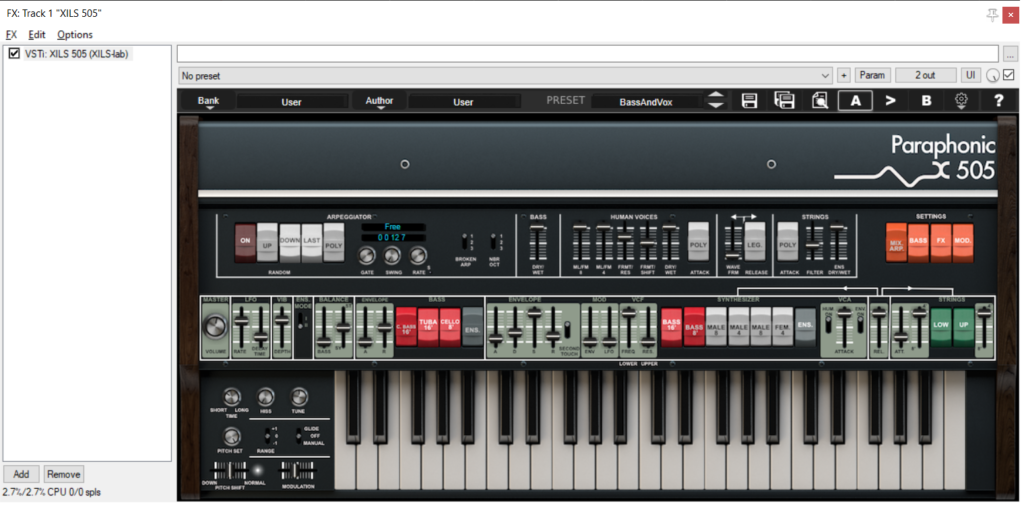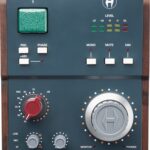The Roland RS-505 string synthesizer is a true 70s cult-classic. That time-honored status made the RS-505 a perfect project for those software synth geniuses at XILS Lab. The XILS 505 plugin offers a great emulation of the original; providing musicians a flexible and sonically alluring string synth for their own music projects.
XILS 505 Features
- Accurate Emulation of the Roland RS-505
- A String Synth, Bass Synth, and Synthesizer Rolled into One
- An Top Octave Divider Oscillator with 49 Voices of Polyphony
- Separate Sections for Strings, Voices, Bass, and Synthesizer
- One LFO Used for Vibrato and One Assignable in Modulation Matrix
- Synthesizer Section Has its Own Filter and ADSR Envelope
- Multiple Envelopes Supporting Each Section
- BBD Chorus and Resonant Ensemble Effect
- Stereo Imaging Effect
- Modulation Matrix with 14 Sources and 24 Destinations
- A Powerful Arpeggiator
- Includes Over 100 Presets
- Available as a VST Plugin for $149 from XILS Lab
If you are a fan of classic string synthesizers, XILS 505 belongs in your collection. The emulation is of the high standard typical of other XILS Lab releases, like XILS 4 and PolyM, both of which we previously reviewed. Importantly, XILS 505 features the same flexibility that helped the Roland RS-505 grace many classic albums of yore. Let’s check it out.
The XILS 505 User Interface Looks Like The Original Roland RS-505
In a similar manner as the other XILS Lab synths we reviewed, the XILS 505 interface is a dead ringer for the hardware it’s emulating. In this case, expect a fine representation of the Roland RS-505 interface… with benefits. This approach makes sense, as the folks at XILS typically add extra functionality to their synth emulations. Such is the case with XILS 505 as we will see.

At the top of the virtual 505 lies an Advanced Settings panel with extra parameter pages, with four orange rocker switches controlling access to each page. The “ARP Mixer” section is the default, with controls for the arpeggiator and other esoteric functionality specific to the XILS 505 emulation. Other pages reveal advanced settings for the bass section, the effects engine, and the modulation matrix.
Below this panel lies the heart of XILS 505 which closely follows the original layout of the RS-505. A variety of sliders, switches, and a volume knob serve to control the overall sound. To the right of the volume knob lies the LFO section with an additional vibrato control. Other sliders manage the balance between the string and synth circuitry and the overall level of the bass.
Speaking of which, the Bass section includes its own envelope and a variety of rocker switches to dial in your low-end. A comparatively large Synthesizer section includes an ADSR envelope, a resonant filter, modulation levels, a VCA, and those ubiquitous rocker switches to tweak the sound. Finally, the String section features faders to control the attack time and octave balance. Rocker switches control whether the lower, upper, or both sections of a keyboard trigger the strings.
An Authentic String Synthesizer Sound
If you noticed our earlier reviews of XILS synths linked earlier, the company is known for its dead-on emulations of classic, legendary synthesizers. XILS 505 offers no exception to this rule. The plugin captures the unique sound of the 505, from the bass to the eerie human voices to the strings themselves.
Peruse the over 100 presets to get a feel for the sonic range of the XILS 505 as well as the unique features not found in the original. XILS plugins typically feature great preset management, making it easy to sort and search for the specific sound you need. There are also a few tutorial presets to help your understanding of the synth architecture.
The 505’s modulation matrix especially provides the means to add some flow and motion to the typical string synth sounds. Of course, I generally keep the rich ensemble circuit powered on whenever using the synth; the resonant phaser adds that creamy quality that never goes out of style in my mind.
As noted earlier, the Synthesizer section includes an ADSR envelope and a resonant filter, although the bass notes use the envelope in the Bass section. This section also includes four divide down oscillators. A convenient switch provides the option to replace these with human voices. A separate attack slider controls these voices.
One cool feature of the plugin not in the original RS-505 is the ability to control the formant filter for the human voices. A vibrato depth fader also adds to the fun, and is part of the LFO with separate delay time and rate faders. Once again, keep that Ensemble switch on. Your ears will thank you.
Advanced Settings Allow For Extra Synth Tweaking
The Advanced Settings panel gives you access to additional parameters to dial in the sound you want. The Bass settings provide filter settings for the three sounds used for the bass: tuba, contrabass, and cello. It also includes a convenient schematic describing the XILS 505 internal architecture.
The Effects section offers the means for tweaking the killer phaser, the reverb, and the ensemble. Check out the Stereo Space section for even more fun. Throughout the stereo image, you get to place the dry sounds of the bass, strings, and synth sounds, as well as the output of the Ensemble circuit. This is so cool!
Finally, the Modulation section lets access the synth’s internal mod matrix. Rocker switches control the LFO shape, while a fader controls its rate. You also get a few faders to tweak the internal DASDR envelope. There are also six modulation nodes where you are able to select a source and destination for each. Both monophonic and polyphonic sources and destinations add to the fun.
Don’t forget the powerful XILS 505 arpeggiator, which is also accessed from the Advanced Setting panel. The parameters should feel familiar to any veteran synthesizer user.
If you are looking for a top notch string synthesizer in a plugin, your search likely ends with the XILS 505. A top notch emulation of the classic Roland RS-505, the extra features not found in the hardware truly make this plugin worthy of your time. We recommend it!
